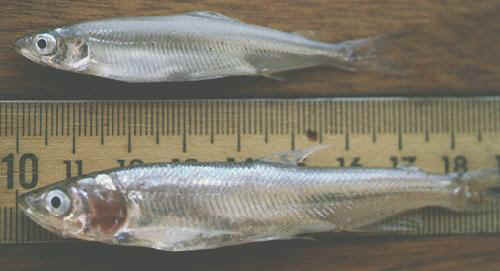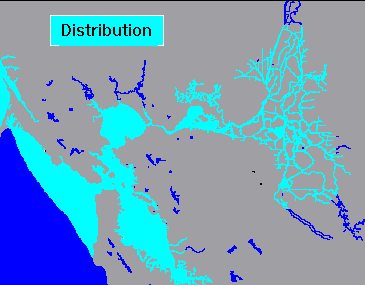Longfin Smelt to be Considered for Possible Federal Protection under ESA; Service finds petition contains sufficient information to conduct next-step study Contacts:
Al Donner 916/414-6566
May 6, 2008. The U.S. Fish and Wildlife Service (Service) today announced its determination that a petition has presented sufficient information about the imperiled condition of the longfin smelt to initiate a status review and consider listing it for protection under the federal Endangered Species Act (ESA).
 |
Delta Smelt (top,) Longfin Smelt (bottom)
Photo courtesy of DFG |
The Service's determination today, commonly known as a 90-day finding, is the first step toward possible protection for the species under the ESA. The action is based on the information provided in a petition to list the longfin smelt (Spirinchus thaleichthys) population that lives in San Francisco Bay/Sacramento-San Joaquin Delta and on information readily available to the Service. The petition asked that the Service list longfin smelt within that area as a distinct population segment (DPS). The finding is available at http://www.fws.gov/sacramento/.
Today's action by the Service opens a 60-day public comment period, closing July 7, 2008, during which experts and the public are encouraged to submit all relevant information about the species. The Service then will complete its next stage of review, commonly known as a 12- month review.
 |
The extent of Longfin Smelt distribution
Image courtesy of DFG |
Longfin smelt is an anadromous species, about 5 inches long, that tolerates wide ranges of salinity. It has a two-year life cycle, typically spawning in Suisun and San Pablo bays from November to June. Outflow from Central Valley rivers into the bays has been correlated with longfin smelt numbers.
The petition was filed Aug. 8, 2007 by three environmental organizations: Bay Institute, Center for Biological Diversity and Natural Resources Defense Council. The petition asserted that the Bay-Delta population is physically and reproductively isolated from populations further north, that it is genetically differentiated and lives in a unique ecological setting. It also argues that reduced outflow caused by exports from the Delta has contributed to decline of the longfin smelt.
In 1992 a similar petition to list the entire population of longfin smelt, which ranges from San Francisco Bay to Alaska, was filed with the Service. In 1993 FWS issued a positive 90-day finding. But in 1994, in its 12-month finding, the Service concluded that the petition was not warranted because, although the Bay Area longfin smelt population was declining, it did not seem "biologically significant to the species as a whole, and may not be sufficiently reproductively isolated." In its 1994 decision, the Service acknowledged that longfin smelt numbers in the Delta had declined by 90 percent since 1984.
One index, the Fall Mid-Water Trawl Survey recorded an annual average of only 537 longfin smelt from 1987 through 1994, whereas in the previous 20 years it had averaged more than 17,000. Just after the 1994 decision, California experienced a wet period and the annual index rose to more than 4,000 during the years from 1995 to 2000. Then, from 2001 through 2006, the index dropped to an average of 569 each year. In 2007 the index dropped to a record low of just 13.
"The Service has not made a decision on whether to propose listing the longfin smelt," said Steve Thompson, regional manager of the Service's region 8 (California/Nevada). "The 90-day finding is our recognition that new information has developed."
Thompson continued, "Over the next few months, the Service will evaluate this new information, and all the additional information we obtain, then make a decision on whether there is sufficient risk to the species to proceed with a listing proposal."
Comments may be submitted until July 7, 2008. Comments may be submitted by one of the following methods:
1) Federal eRulemaking Portal: http://www.regulations.gov and follow the instructions for submitting comments;
2) U.S. mail or hand-delivery to: Public Comments Processing, Attn: FWS-R8-ES-2008-0034, Division of Policy and Directives Management; U.S. Fish and Wildlife Service; 4401 N. Fairfax Drive, Suite 222; Arlington, VA 22203.
All comments will be posted on http://www.regulations.gov.
Today's notice is found in the Federal Register at http://edocket.access.gpo.gov/2008/pdf/E8-9835.pdf